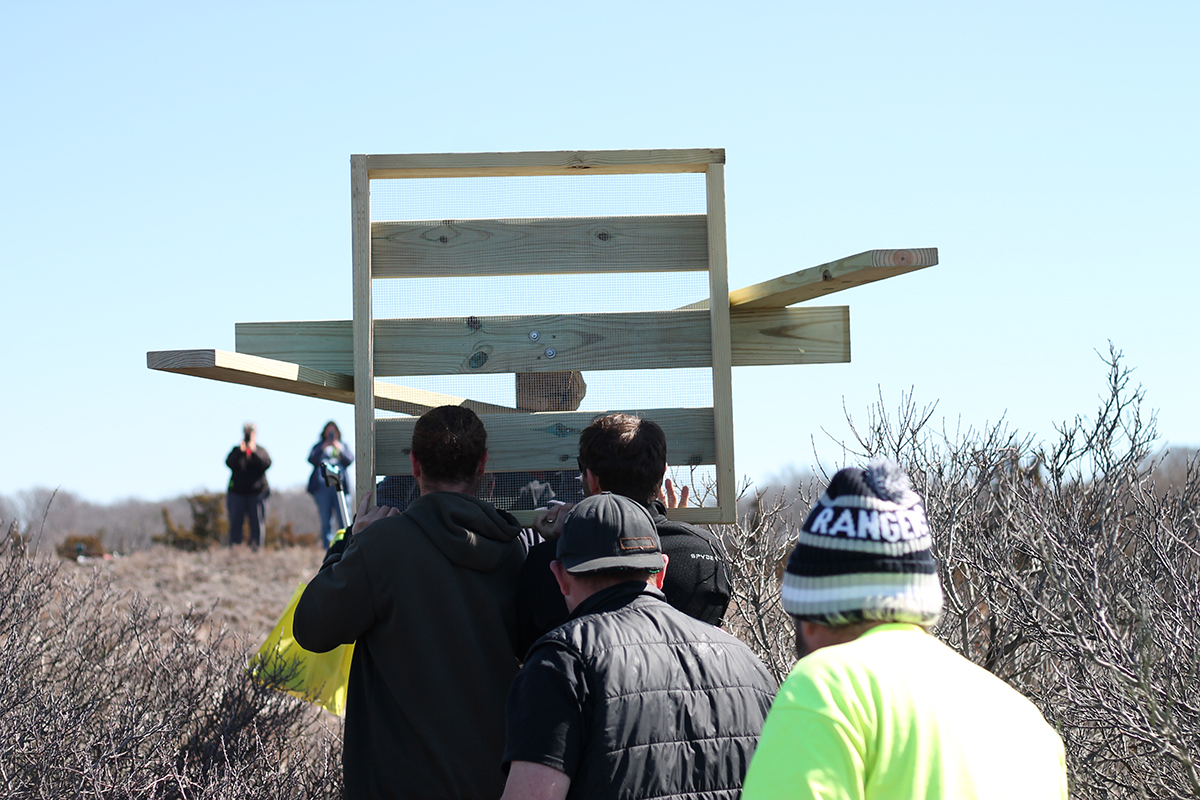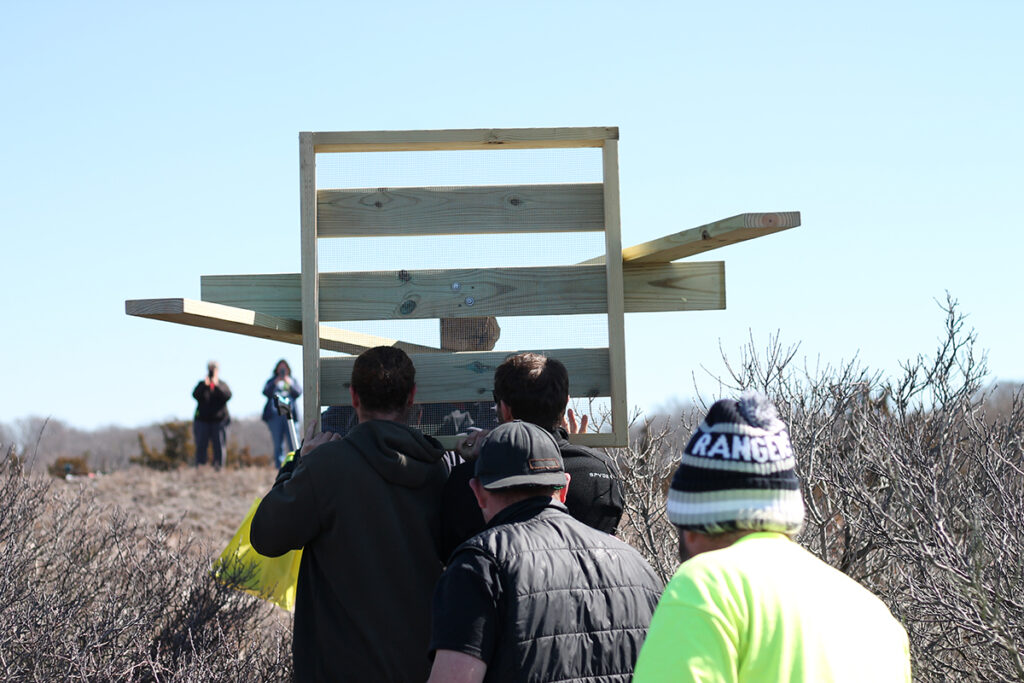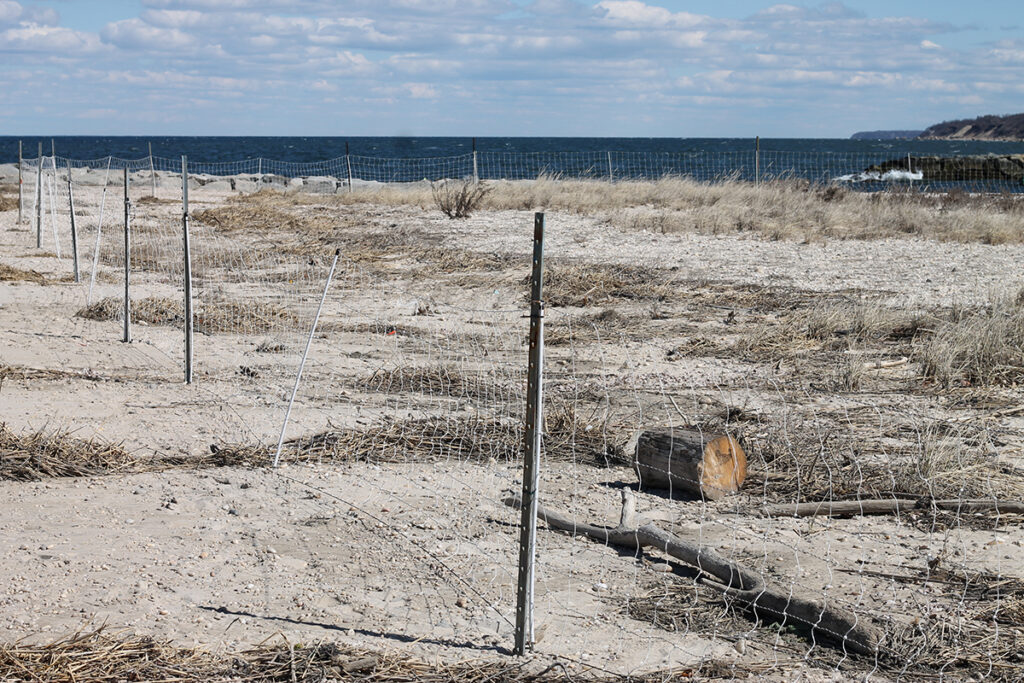


About thirty community volunteers gathered on Breakwater Beach in Mattituck, Saturday, March 16 for an event celebrating the spring return of the osprey — a fish-eating raptor that breeds on Long Island.
The afternoon included a beach cleanup, pebble and stick collection, installation of a second osprey nest platform and shorebird fencing designed to protect nesting sites of two endangered species — piping plovers and least terns.
It was a true community effort, with several organizations involved. The event, which has been growing since it started in 2016, was organized by Jennifer Murray of Turtleback Environmental Education Center. The osprey nest platform was funded by community resident Richard Rivera. Ben Hines of the Mattituck Park District oversaw the building and installation of the nest platform. Volunteers of all ages came out to do the work, and the North Fork Audubon Society will monitor the fenced in nesting sites for the town of Southold.
The osprey is a typical sign of spring along the shore. Ms. Murray said as primarily fish-eaters, they nest in tall open trees near water. They migrate as far as 2,500 miles down to South America, and come back north in the spring to nest and breed. She said radio tags affixed to osprey have documented some birds fly over 200 miles in a day, over large bodies of water without stopping.
“Osprey are going strong on the North Fork,” Ms. Murray said. This second nest platform was installed simply because of the bourgeoning population. Osprey were spotted in the area as soon as March 13, which is slightly earlier than their typical return between St. Patrick’s Day, March 17 and the spring equinox, March 19.
Ms. Murray emphasized the need for the beach cleanup part of the event. She said osprey build large nests that weigh up to 200 pounds. They use what they find, sticks or otherwise. “They’ll pick up baseball caps and children’s toys,” Ms. Murray explained. “They may put landscape fabric, balloon string and fishing line.” The danger of plastic and marine debris in osprey nests, Ms. Murray said, is the birds and chicks becoming entangled in it.
During the beach cleanup — where volunteers collected over 100 pounds of garbage — Ms. Murray checked the original nest platform on Breakwater Beach, pointed out and removed, dangerous items that had been brought back to the nest. They included balloon string and a holiday wreath made of wire. She said she has heard of crab traps and even a great black back gull skeleton being woven into osprey nests.
(Daniel Franc photos)
The nest platform was carried to its designated site high in the beach dunes by Mr. Hines and the volunteers. Mr. Hines dug a 3-foot hole with an electric auger. The collected pebbles were used to fill the platform support holes, and the sticks were tossed up onto the platform to “seed” it. Ms. Murray said that putting sticks onto the platform makes the osprey more likely to adopt the site for its nest.
Ms. Murray said the males arrive first to scope out a new nesting site or to tidy up an old one. Roughly a week later, the females arrive and the osprey breeding season commences.
The first platform at Breakwater was used by a nesting pair last year. “The ospreys last year loved this one,” Mr. Hines said. “By September they’d follow me along as I cleaned the volleyball courts,” he noted. Ms. Murray said that those osprey will likely use the site again this year, as the species tend to migrate back to the same site. She said although young birds may fight over nesting sites on the outset, once claimed, osprey don’t mind having neighbors in their territory, so having two platforms nearby on the same beach shouldn’t pose a problem.

Ms. Murray said the installation of repurposed sheep fencing serves multiple purposes. Shorebirds, such as piping plovers and least terns, nest right in the sand. People can step on nests, eggs or chicks without realizing it. The fencing keeps beach users from walking through the nesting area.
She said the least terns had been abandoning the colony site for several years prior to the fence installation. “It was too much disturbance,” she explained. “That means they leave their eggs and young behind. When they feel there is a threat, they just go.” Last year, however, least terns did not abandon the nesting site, and Ms. Murray believes it’s because of the fencing.
Ms. Murray said the fencing installed last year had a secondary benefit of keeping garbage from overflowing receptacles during peak beach season from blowing onto the beach. It is also visible at night, which is an added benefit.
No ospreys were seen the day of the Return of the Osprey event, however Breakwater Beach is ready.
24World Media does not take any responsibility of the information you see on this page. The content this page contains is from independent third-party content provider. If you have any concerns regarding the content, please free to write us here: contact@24worldmedia.com
